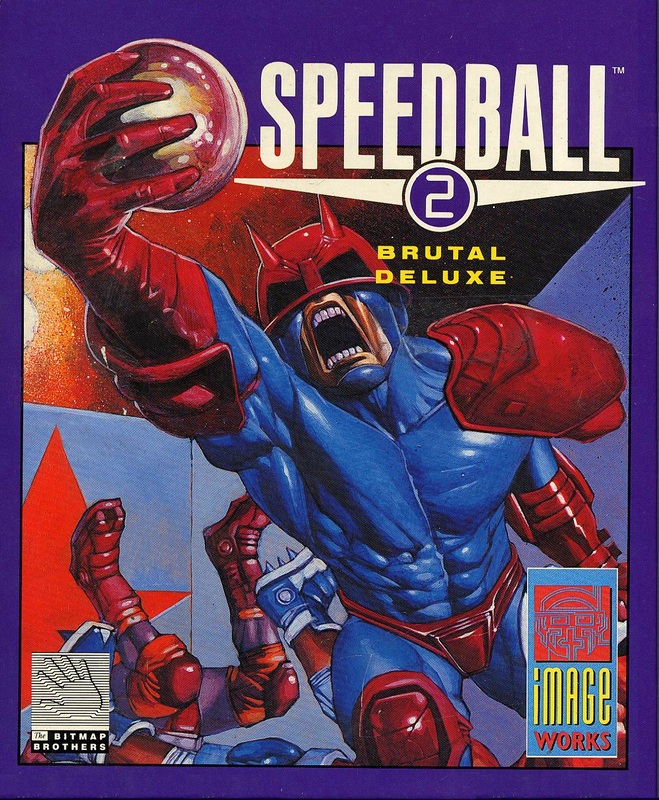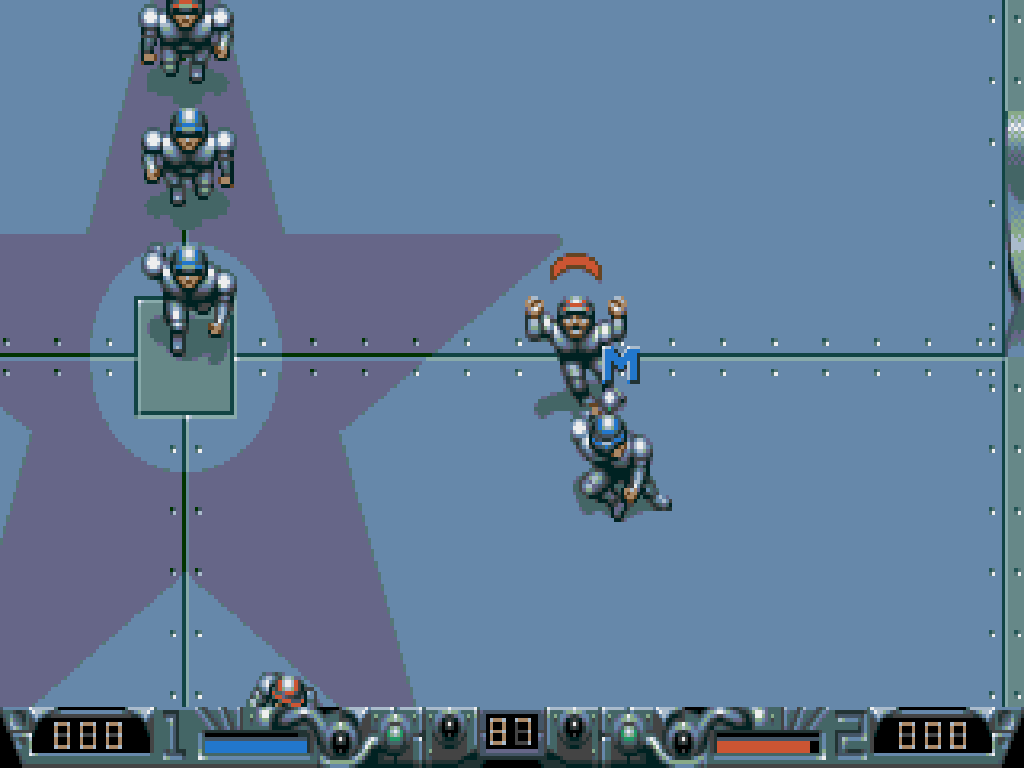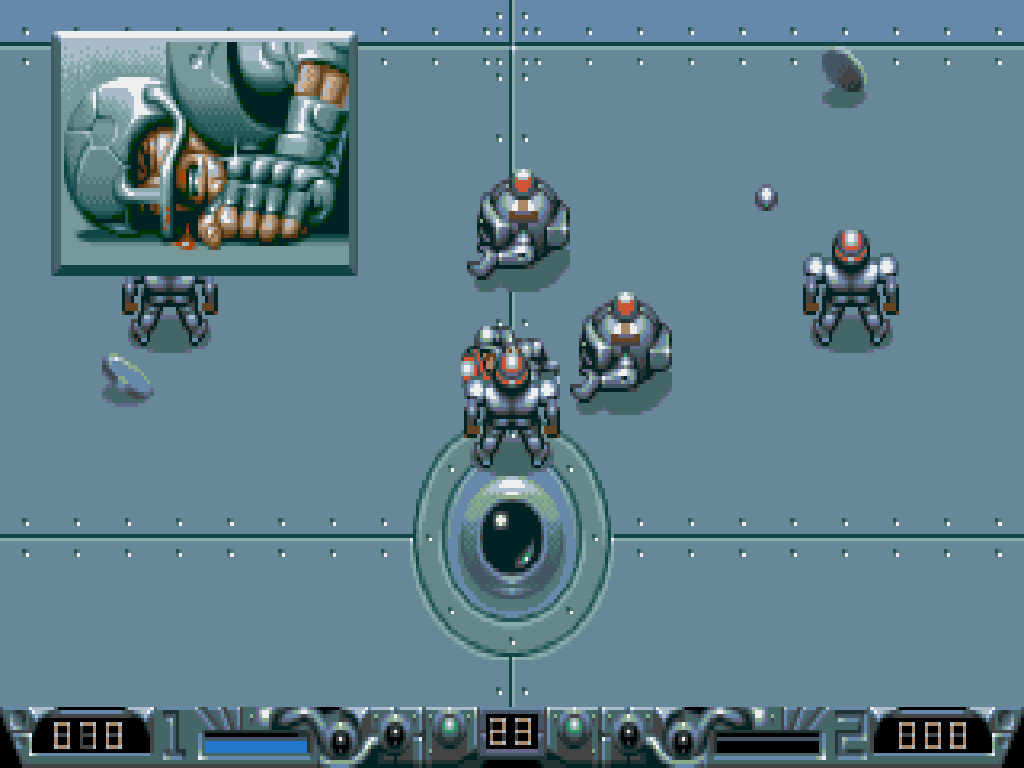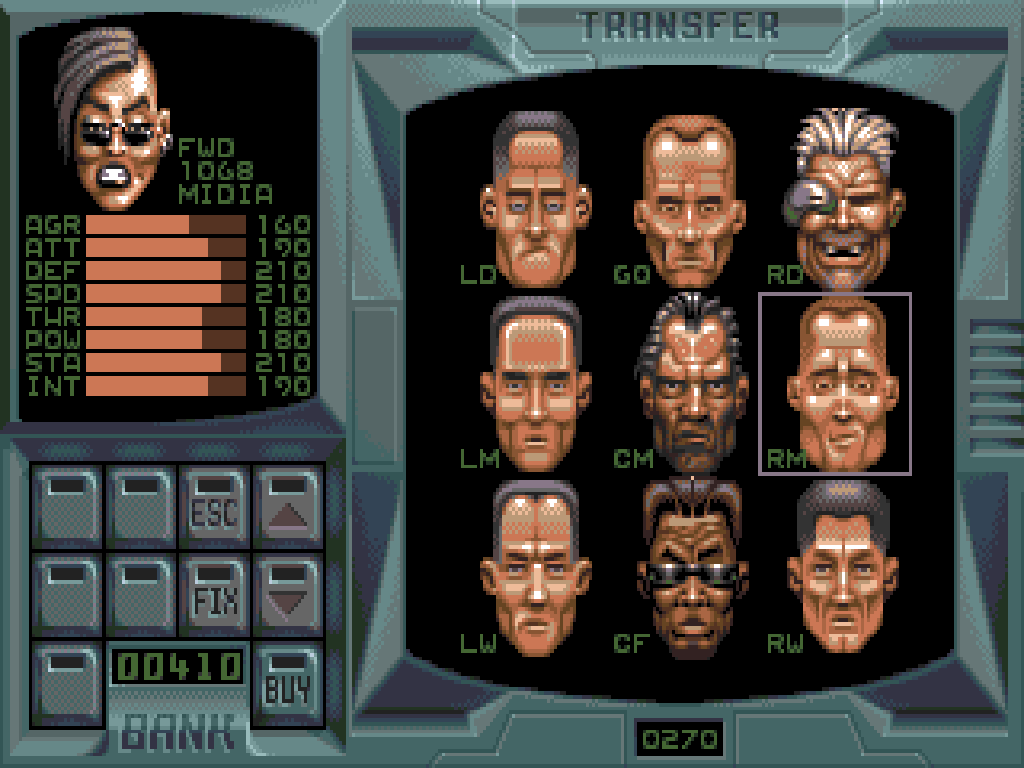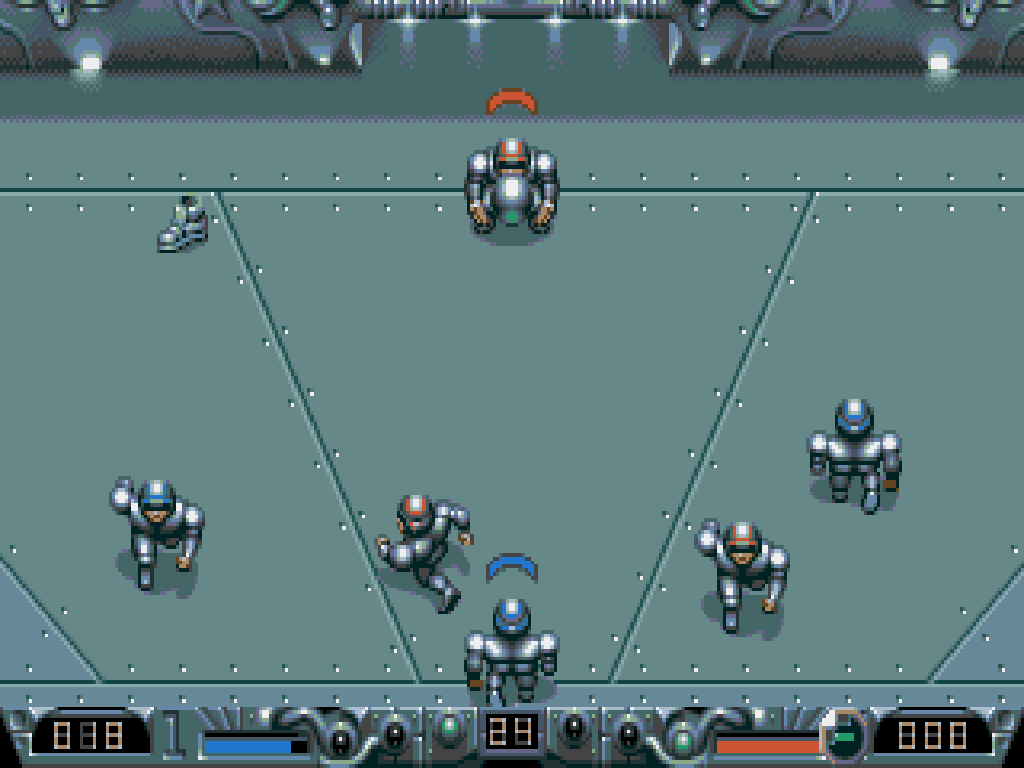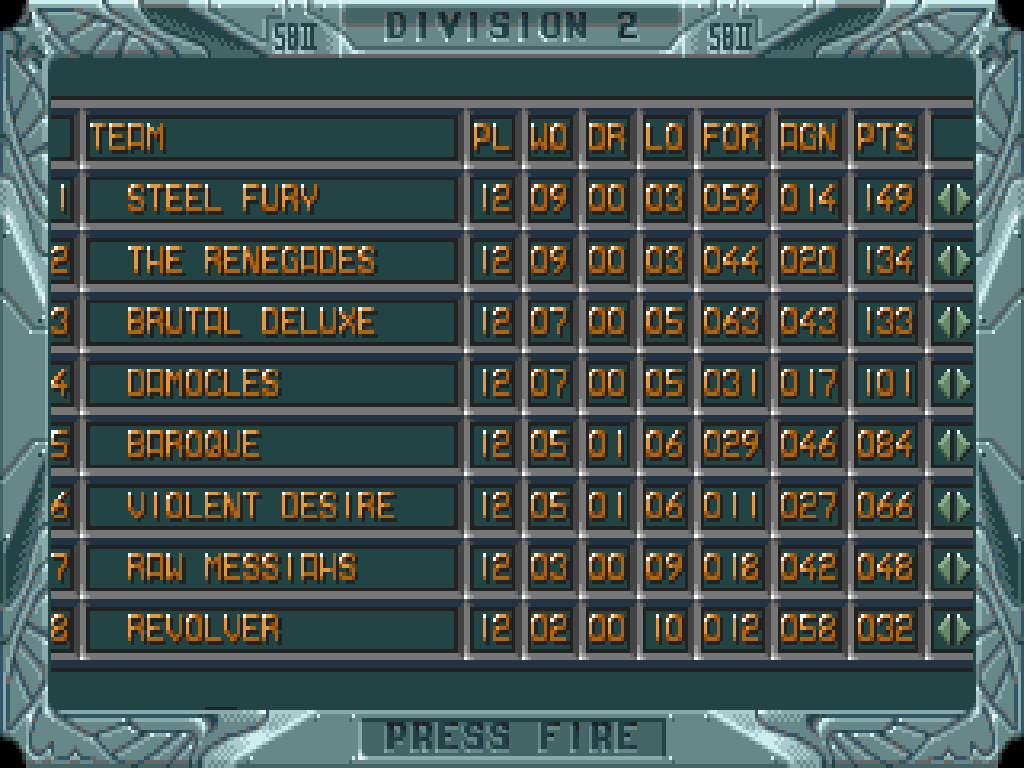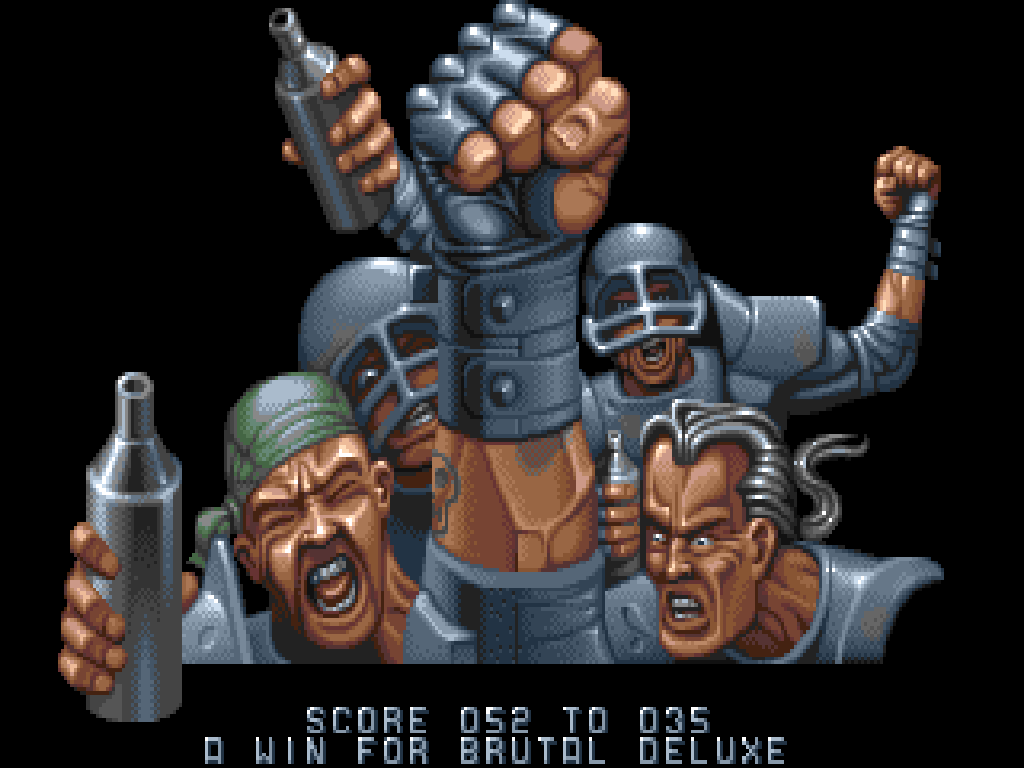SPEEDBALL 2: BRUTAL DELUXE (AMI)
If Speedball 2 was advertised by Carlsberg it would probably be the best game ever made. Despite its humble 16-bit credentials and basic 2D top-down view of the action the Bitmap Brothers sprinkled a little bit of gameplay awesome dust over their future sport simulation, meaning Speedball 2 remains highly regarded today despite it being 20 years since its original release. There remains something tantalisingly delightful about games of yonder, programmed by individuals in solitary confinement, which thrived on the burgeoning technology of the era, yet produced unique titles that have ignored the passing sands of time, to be rightly hailed as the glorious betters of most next-gen titles. No probably about it, actually. Speedball 2 is the best game ever made!
Speedball… a violent future sport with one rule, slam a solid steel ball into your opponents goal. Or, for a laugh, into your opponents face! Nine hulking brutes against nine hulking brutes, a large multi-directional scrolling playing field featuring more than one way to score, and the irregular calls of ‘ice-cream’ from the vendors in the stands can only mean the start of the Speedball season. This year a new team has arrived on the scene; the toughly named Brutal Deluxe. Problem is their name belies the fact they are probably the worst team ever to grace Speedball history. Worse still, you’ve been given the honour of attempting to turn them into champions. With only 14 weeks to reach the top flight, can you create a team of bloodthirsty super-humans with deft Speedball ability to steam-roll over the likes of Fatal Justice and Steel Fury?
Designed by the Bitmap Brothers (not real brothers), creators of a festival of classic Amiga games (Xenon 2: Megablast, The Chaos Engine), Speedball 2 advances upon the original concept of Speedball greatly. In some ways it’s more of the same, yet entirely different – the perfect ingredients in sequel making. The original Speedball was a fun if short-lived experience. Whilst, the basic elements made for some frantic two-player action, the single player game was rather simple and unchallenging. Not good for hermits; pretty good for squabbling brothers. Furthermore, the play area was relatively tiny resulting in little strategy and restricting gameplay somewhat – it all got a little bit samey all too quickly.
Did you know? A Speedball is the term given to a mix of heroine and cocaine: a combination thought to be almost as addictive as the game!
Speedball 2 retains the basic concepts of its predecessor - score lots of goals whilst beating the blue hell out of opponents – but improves immensely on said flaws by adding a few masterstrokes to the erstwhile simplicity. Firstly, the inclusion of a more structured management feature to enhance the single player experience is a massive step forward. Transforming your team into winners with a canny bit of training before every match along with dipping into the transfer market to beef up the bunch of weaklings at your command adds much needed depth. The additional management dimension makes for an intriguing single-player game as you begin to plan stratagems for future matches - do you buy new, superior players or train-up the original squad slowly until they turn into superhuman behemoths? Spending cash on the correct attributes for your positional players or bringing in star players at the right time makes a huge in game difference. Balls-up this aspect and Super Nashwan will be stomping on your testicles for breakfast.
The second masterstroke consists of the actual matches. Gone is the tiny arena of Speedball with its functional two-way vertical scrolling. Instead the Bitmap’s replaced this with a massive eight-way multi-directional scrolling pitch that seems about eight times the size of the original. Vast it is. Of course, a bigger play area provides more opportunities and, again, the Brothers don’t disappoint. Firstly, there is much variety in how to go about winning games. Not content with the normal route of throwing the ball in the goal, two bounce-domes, crippling an opposing player, or hitting one of five stars on the sidewall of the arena provide additional methods of scoring. Additionally, points can also be deducted from the oppositions score by hitting the stars they have previously lighted. Already the scope for more strategic play is obvious - a “proper” goal is not even necessary to win.
The second masterstroke consists of the actual matches. Gone is the tiny arena of Speedball with its functional two-way vertical scrolling. Instead the Bitmap’s replaced this with a massive eight-way multi-directional scrolling pitch that seems about eight times the size of the original. Vast it is. Of course, a bigger play area provides more opportunities and, again, the Brothers don’t disappoint. Firstly, there is much variety in how to go about winning games. Not content with the normal route of throwing the ball in the goal, two bounce-domes, crippling an opposing player, or hitting one of five stars on the sidewall of the arena provide additional methods of scoring. Additionally, points can also be deducted from the oppositions score by hitting the stars they have previously lighted. Already the scope for more strategic play is obvious - a “proper” goal is not even necessary to win.
In addition the pitch provides a range of other features to help and hinder players. The electrobounce, warp gate and generous littering of power-ups have a variety of in-game effects to keep things interesting, none of which, however, can match the pure genius of the point multiplier. Shoot the ball up the multiplier chute and it multiplies your scoring by half. Do so for a second time and it doubles your output. Such is the advantage one can receive half of the match can be spent battling for control of the multiplier before any thought is given to scoring actual points. The bonus here is that the computer AI is equally attuned to the benefits of the score multiplier and perhaps this is the greatest element to Speedball 2’s success. The AI and difficulty setting are absolutely spot on.
For once, the computer-controlled players don’t do stupid things beyond your control. Any goals conceded are nearly always down to human error. Likewise, the one way to score phenomena prevalent of the time is conspicuous by its absence. Most importantly, though, computer opponents are proper tough giving the player little quarter, particularly at the business end of things. In fact, Speedball 2 is one hell of a challenge. Whilst it features an appropriate learning curve, allowing one to learn the game mechanics against the relative safety of Revolver and Raw Messiahs, once promoted to Division 1 you pretty much become the whooping boys to be picked on by the likes of Powerhouse, Rage 2000 and the mighty Super Nashwan. At this point Speedball 2 accelerates into an insane hyper-mode of frantic action and is jaw-dropping in it’s amazing pace. Yet curiously it does not frustrate. These teams can be beaten on your day; it just requires consistency of play and determined concentration to win through. And very slowly those close defeats start to become nervy victories.
To this day I’ve only won the Speedball 2 league trophy the once. Likewise, I’ve very rarely managed to beat my arch nemeses of the game, the deplorably fantastic Super Nashwan (or utter b*stards), but the sense of achievement when this is attained is, well, rather immense. Speedball 2 is quite simply a fantastic challenge. No game grabs you with such fiendish addictiveness (due to the exquisite learning curve and the marvellous simplicity) and two decades later, it still hasn’t let go. In terms of enduring and lasting gameplay, nothing can quite top the Bitmaps' masterwork.
For once, the computer-controlled players don’t do stupid things beyond your control. Any goals conceded are nearly always down to human error. Likewise, the one way to score phenomena prevalent of the time is conspicuous by its absence. Most importantly, though, computer opponents are proper tough giving the player little quarter, particularly at the business end of things. In fact, Speedball 2 is one hell of a challenge. Whilst it features an appropriate learning curve, allowing one to learn the game mechanics against the relative safety of Revolver and Raw Messiahs, once promoted to Division 1 you pretty much become the whooping boys to be picked on by the likes of Powerhouse, Rage 2000 and the mighty Super Nashwan. At this point Speedball 2 accelerates into an insane hyper-mode of frantic action and is jaw-dropping in it’s amazing pace. Yet curiously it does not frustrate. These teams can be beaten on your day; it just requires consistency of play and determined concentration to win through. And very slowly those close defeats start to become nervy victories.
To this day I’ve only won the Speedball 2 league trophy the once. Likewise, I’ve very rarely managed to beat my arch nemeses of the game, the deplorably fantastic Super Nashwan (or utter b*stards), but the sense of achievement when this is attained is, well, rather immense. Speedball 2 is quite simply a fantastic challenge. No game grabs you with such fiendish addictiveness (due to the exquisite learning curve and the marvellous simplicity) and two decades later, it still hasn’t let go. In terms of enduring and lasting gameplay, nothing can quite top the Bitmaps' masterwork.
Finally, the whole package is tied up into a neat little bundle. The
graphics have a superb metallic sheen and neo-fascist brutalism that provides
an entirely appropriate arena for the action, but the key thing is the speed of
the sprites. They are rapid! Speedball 2 is played at a furious, frantic, breathless
and often reckless pace, which makes for a simply dynamic experience. The fact
there are no glitches and the frame-rate keeps up with such a hectic pace is
breathtaking, particularly in the latter stages when the matches become a blur
of speed and reflex. Add to this some decent presentation screens throughout, a
quality opening theme tune and the odd cry of “ice-cream” (which always raises
a smile) amongst the cheering crowd and this is the veritable icing on the
cake.
So, despite Speedball 2 being a simple game of two equal halves of ninety seconds with a pitch environment that never differs, it remains the construct of a truly magnificent game. Just look at the PC remake a few years back. Over-complicated in design with too much graphical style that turned the pace of the game into a wretched slug; less is indeed more. Likewise, Speedball 2’s legacy continues to shine even 20 years later. The PS Minis version released earlier this year is testament to that. But the original Amiga game still pisses an infinite amount of piss over any pallid pretenders to the throne. The superb mix of tactics and outright violence, coupled with the downright sheer addictiveness and amazing frantic pace would normally be sufficient. Yet the addition that few games are as challenging or have the nous to keep you coming back for more (despite Super Nashwan laughing in your face) time after time after time, simply adds to the make up of the greatest game of all time. Ever!
So, despite Speedball 2 being a simple game of two equal halves of ninety seconds with a pitch environment that never differs, it remains the construct of a truly magnificent game. Just look at the PC remake a few years back. Over-complicated in design with too much graphical style that turned the pace of the game into a wretched slug; less is indeed more. Likewise, Speedball 2’s legacy continues to shine even 20 years later. The PS Minis version released earlier this year is testament to that. But the original Amiga game still pisses an infinite amount of piss over any pallid pretenders to the throne. The superb mix of tactics and outright violence, coupled with the downright sheer addictiveness and amazing frantic pace would normally be sufficient. Yet the addition that few games are as challenging or have the nous to keep you coming back for more (despite Super Nashwan laughing in your face) time after time after time, simply adds to the make up of the greatest game of all time. Ever!
